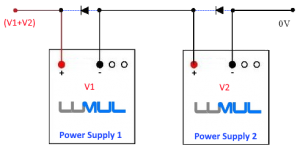Whilst learning about electricity in science class during our formative school years, we were all taught how batteries could be connected in series or parallel, to either increase the voltage or increase the current available. What we learned was relatively simple:
- Connect two 4V batteries in series and you’d effectively get an 8V battery
- Connect two 4V batteries in parallel and your “new battery” would effectively last twice as long given the same load
It seems obvious then, that it’s equally possible to wire low voltage switching power supplies in parallel or series, to get the same type of result as with our batteries. The truth is that it’s not so simple and just like adult life out of school, “it’s complicated”.
Connecting switching power supplies in series
When we were learning about electricity with batteries, we took two batteries of the same type and voltage and connected them in series to double the voltage. Connecting switching power supplies in series is possible, but there are some rules to follow. As with our science class lessons with batteries, with power supplies connected in series the output voltage will be the sum of the voltages of the two power supplies.
Voutput = V1 + V2
So as an example, if you require a 36V driver you can connect a 12V and a 24V driver in series.
But what about current ? It does seem intuitive that if you are powering a device which requires 5A that both power supplies connected in series can offer 5A. Building on our example above, this means we should use a 12V 60W power supply and a 24V 120W power supply. In fact, we only need to ensure that if our device draws 5A each driver being connected in series should support at least 5A – they can support a higher current without any issue. Again using our example, we could connect a 12V 120W power supply in series with a 24V 120W power supply to drive our 36V 5A device.
It is important to note, that every power supply has a breakdown voltage – a voltage at which it will fail. When connecting power supplies in series, it is imperative that you ensure that the total output voltage never exceeds the breakdown voltage of any one of the individual power supplies.
Lastly, connect a reverse-based diode between the terminals of each power supply to prevent reverse voltage if one power supply reaches full voltage before the other on power-on.
- Rule 1 : When connecting power supplies in series, ensure they have the same output current
Rule 2 : When connecting power supplies in series, place a diode on each power supply between the terminals to prevent reverse voltage. Most Mean Well power supplies already have diodes built-in but make sure … - Rule 3 : Never allow the resultant output voltage to exceed the breakdown voltage of any one of the power supplies

Here are some examples of possible combinations of power supplies connected in series :
- 12Vdc@30A power supply in series with a 24Vdc@9A power supply can be used as a 36Vdc@9A power supply.
- 12Vdc@60A power supply in series with a 5Vdc@37A power supply can be used as a 17Vdc@37A power supply.
- 9Vdc@20A power supply in series with a 6Vdc@68A power supply can be used as a 15Vdc@20A power supply
- 5Vdc@20A power supply in series with a 6Vdc@14A power supply and in series with a 7Vdc@25A power supply can be used as an 18Vdc@14A power supply
Connecting switching power supplies in parallel
We’ve established that it’s quite possible and feasible to connect two power supplies in series, with three very important rules to observe, which is really in line with what we learned about connecting batteries in series when we were at school. In those science class lessons, we learned that we can connect batteries in parallel as well. Is this possible with power supplies? The answer is “yes and no” …
Connecting switching power supplies in parallel could cause both power supplies to fail
As a broad guideline rule, you cannot and should not connect two switching power supplies in parallel. There is an exception to this which we’ll get to shortly, but the main reason why most switching power supplies should never be connected in parallel, even if they claim to be same voltage, same make, same current : one power supply will generally bear more load than the other and this will cause that power supply to fail, and then the second power supply will fail due to being overloaded. This is where the exception comes in: some power supplies, but very few, have been designed to support being connected together in parallel. These power supplies have a current sharing function, some of the ranges of Mean Well power supplies which can be safely connected in parallel include: SDR, TDR, PSP, RSP & RST. These power supplies will have a P (LP/CS) terminal which you should connect between the power supplies. Even with these power supplies connected correctly, there are still “issues” such as if the load falls below 10% of the rated load of any one of the power supplies in which case the power supplies start to “play up”.
Even when power supplies are designed to support parallel connection, it’s not perfect and there are issues.

Rule 4 : Do not connect switching power supplies in parallel
